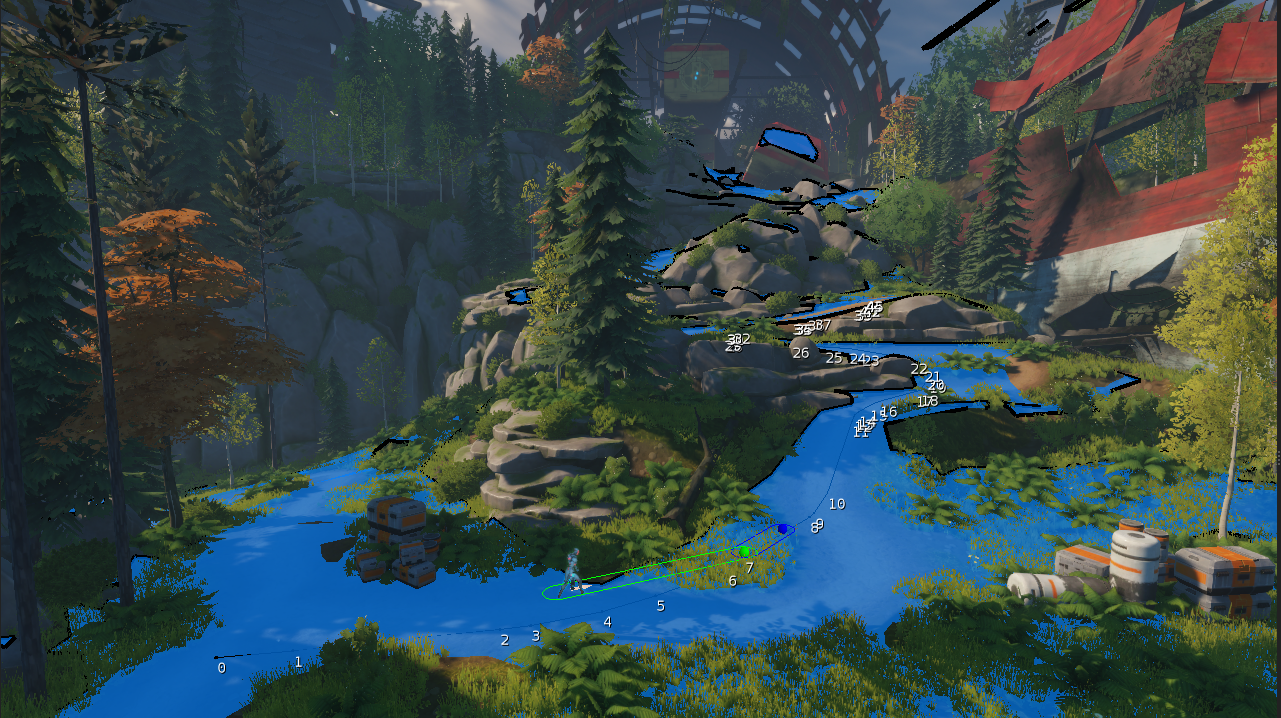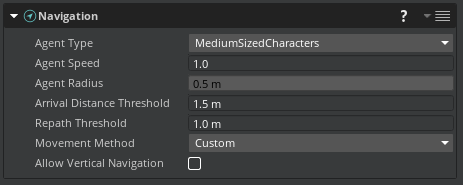IN THIS ARTICLE
Navigation Component
The Navigation component provides path-finding and path-following functionality for AI movement, typically on a navigation mesh.

Navigation Component Properties
The Navigation component has the following properties:

Agent Type
Specifies this AI’s entity type for navigation purposes. Defining the agent type determines which
navigation area
the entity follows in a scenario where there are different navigation meshes for larger vehicles and smaller humanoid bots. These agent types are defined in the Scripts\AI\Navigation.xml file of your project.
To define an agent type on your navigation area, see the Navigation Area component.
Agent Speed
Sets the speed of the agent while navigating when using the Transform or Physics movement methods.
Default value: 1
Agent Radius
Sets the entity radius for navigation purposes. Independent of physics or other collision concerns, the pathfinder uses this value to move around an area with obstacles while cutting corners.
Default value: 4
Arrival Distance Threshold
Sets the minimum distance from an end point when an entity’s movement stops and is considered complete.
Default value: 0.25
Repath Threshold
Sets the minimum distance from the previously known location before an entity’s new path is calculated.
Default value: 1
Movement Method
Sets the movement method to use when following a path. This can be Transform, Physics, or Custom.
Default value: Transform
- Transform - Move the entity that this component is on using the Transform bus. This method ignores all physics so the object may go through walls and terrain.
- Physics - Move the entity using physics if the entity has a PhysX Rigid Body, PhysX Character Controller, Rigid Body Physics or Character Physics component. If the entity does not have one of these valid physics components it will not move.
- Custom - Provide path updates and let the game logic move the entity however they want. This method is useful when you want to move an animated entity that uses root motion. By listening to the
OnTraversalPathUpdatenotification, you can move your entity toward the next point along a path. Once the entity gets within the arrival distance threshold anotherOnTraversalPathUpdatenotification with the next path position will be provided and so on until the end of the path is reached.
Allow Vertical Navigation
Set to true if you want to to allow the navigation agent to include the vertical velocity when navigating a path, or false if you just want the velocity to be constrained to the X and Y plane (2D). Vertical navigation can be used for flying entities or entities that move with the Transform method but must move vertically. Enabling this property can also help prevent “stair stepping” for entities moving down ramps or steep terrain.
Default value: false
NavigationComponentRequestBus EBus Interface
Use the following request functions with the NavigationComponentRequestBus event bus (EBus) interface to communicate with other components of your game.
For more information about using the EBus interface, see Working with the Event Bus (EBus) system .
FindPath
Finds a requested path configuration.
Parameters
request - Allows the issuer of the request to override one, all, or none of the pathfinding configuration defaults for this entity.
Return A unique identifier for this pathfinding request.
Scriptable No
FindPathToEntity
Creates a pathfinding request to navigate toward the specified entity.
Parameters
EntityId - ID of the entity toward which you want to navigate.
Return A unique identifier for the pathfinding request.
Scriptable Yes
FindPathToPosition
Creates a pathfinding request to navigate towards the specified world position. Note that while this may seem like the obvious simple choice for pathing, it is often more useful to use FindPathToEntity with a dummy entity because then the pathing will automatically update if you move the dummy entity to a new location before pathing is complete.
Parameters
Destination - World position you want to navigate to.
Return A unique identifier for the pathfinding request.
Scriptable Yes
Stop
Stops all pathfinding operations for the provided requestId. Use the ID to ensure that the request you want to cancel is the request that is currently processing. If the specified requestId is different from the ID of the current request, then the Stop command is ignored.
Parameters
requestId - ID of the request to cancel.
Return None
Scriptable Yes
GetAgentSpeed
Returns the current AI Agent’s speed.
Parameters None
Return Returns the current agent’s speed as a float.
Scriptable Yes
SetAgentSpeed
Updates the AI Agent’s speed.
Parameters
agentSpeed - Specifies the new agent speed as a float.
Return None
Scriptable Yes
GetAgentMovementMethod
Returns the current AI Agent’s movement method.
Parameters None
Return Returns the current agent’s movement method.
Scriptable Yes
SetAgentMovementMethod
Updates the AI Agent’s movement method.
Parameters
movementMethod - Specifies the new agent movement method (Transform, Physics or Custom).
Return None
Scriptable Yes
NavigationComponentNotificationBus EBus Interface
Use the following notification functions with the NavigationComponentNotificationBus event bus (EBus) interface to communicate with other components of your game.
For more information about using the EBus interface, see Working with the Event Bus (EBus) system .
OnSearchingForPath
Indicates that the pathfinding request has been submitted to the navigation system.
Parameters
requestId - ID of the request for which the path is being searched.
Return None
Scriptable Yes
OnPathFound
Indicates that a path has been found for the indicated request.
Parameters
requestID - ID of the request for which the path has been found.
currentPath - The path calculated by the pathfinder.
Return Returns a boolean value indicating whether this path is to be traversed.
Scriptable No
OnTraversalStarted
Indicates that traversal for the indicated request has started.
Parameters
requestId - ID of the request for which traversal has started.
Return None
Scriptable Yes
OnTraversalInProgress
Indicates that traversal for the indicated request is in progress.
Parameters
requestId - ID of the request for which traversal is in progress.
distanceRemaining - Remaining distance in this path.
Return None
Scriptable Yes
OnTraversalPathUpdate
Indicates that the path for the traversal has updated. If the nextPathPosition and inflectionPosition are equal, they represent the end of the path.
Parameters
requestId - ID of the request for which traversal is in progress.
nextPathPosition - Furthest point on the path we can move to without colliding with anything.
inflectionPosition - Next point on the path beyond nextPathPosition that deviates from a straight-line path.
Return None
Scriptable Yes
OnTraversalComplete
Indicates that traversal for the indicated request completed successfully.
Parameters
requestId - ID of the request for which traversal has completed.
Return None
Scriptable Yes
OnTraversalCancelled
Indicates that traversal for the indicated request was canceled before succesful completion. A path request may be cancelled if no path could be found or if the request was stopped by the game.
Parameters
requestId - ID of the request for which traversal was canceled.
Return None
Scriptable Yes
Navigation Pathing Cvars
ai_DrawPathFollower
Enables PathFollower debug drawing, displaying agent paths and safe follow target.
0 - Off
1 - On
